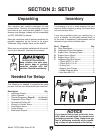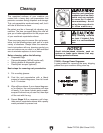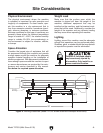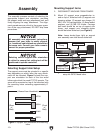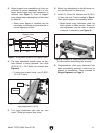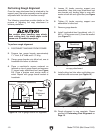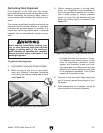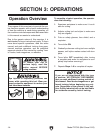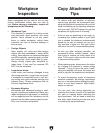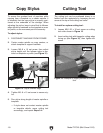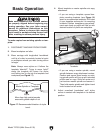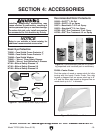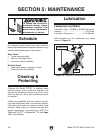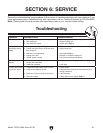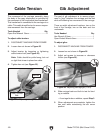
Model T27313 (Mfd. Since 01/15)
-15-
Workpiece
Inspection
• To reduce whip and vibration of relatively
narrow copy spindles, we recommend oper-
ating the longitudinal handwheel with your left
hand and backing up the spinning workpiece
with your right. DO NOT attempt to grip the
workpiece too tightly while it is turning.
• If the cut you are producing is too rough, try
increasing the rotation speed of your lathe
(not to exceed the maximum recommended
speed for the size of material you are turn-
ing) and take a lighter cut. See your lathe’s
instruction manual for recommended speeds.
• As with any other surfacing operation, we
recommend taking multiple passes, rather
than trying to remove too much wood all at
once. This is much safer and will also result
in improved cutting results.
• When making copies, always move the stylus
so it follows the template or master profile
“downhill”. Trying to move the stylus “uphill”
along the template will cause the stylus and
cutter to dig into the template and workpiece.
• To avoid unnecessary waste of expensive
premium materials, we strongly recommend
you turn a test piece before attempting dupli-
cation on your finish material. Make adjust-
ments as required.
• You can save time during duplication by
removing the corners from all of the spindles
you plan on creating before activating the
copy attachment. You will need to make the
cuts with a lathe chisel on your tool rest, prior
to installing the copy attachment.
Copy Attachment
Tips
Some workpieces are not safe to turn or may
require modification before they are safe to
turn. Before turning a workpiece, inspect all
workpieces for the following:
• Workpiece Type:
This machine is intended for cutting natural
and man-made wood products, and some
plastics. Never attempt to cut any metal,
stone, or rubber workpiece; cutting these
materials can lead to machine damage or
severe injury.
• Foreign Objects:
Nails, staples, dirt, rocks and other foreign
objects are often embedded in wood. While
cutting, these objects can become dislodged
and hit the operator, cause tool grab, or break
the turning tool, which might then fly apart.
Always visually inspect your workpiece for
these items. If they can't be removed, DO
NOT turn the workpiece.
• Large/Loose Knots:
Loose knots can become dislodged during
the turning operation. Large knots can cause
a workpiece to completely break in half dur-
ing turning and cause machine damage and
personal injury. Choose workpieces that do
not have large/loose knots.
• Excessive Warping:
Workpieces with excessive bowing or twist-
ing are unstable and unbalanced. Never turn
these workpieces at high speed, or instability
will be magnified and the workpiece can be
ejected from the lathe causing impact injures.
Only turn concentric workpieces!



